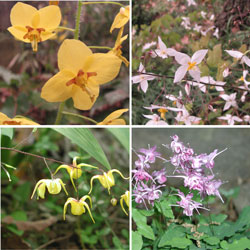Resource Library
Plant of the Week: Epimediums (Barrenworts)
The University of Arkansas System Division of Agriculture does not promote, support or recommend plants featured in "Plant of the Week." Please consult your local Extension office for plants suitable for your region.
Plant of the Week
Epimediums
Latin: Epimedium grandiflorum

Epimediums, commonly called "barrenworts" or to some, fairy wings, are still uncommon in gardens even though they offer a lot that makes them special. Gardeners that know Epimediums at all probably know Epimedium grandiflorum or one of its clones that have been occasionally offered in nurseries for more than a century. But since the opening of China in the 1980s, the number of new species being introduced exploded and continues today. Let's explore some of the diversity of the Epimediums.
Epimediums are woodland herbaceous perennials of the barberry family with more than 50 species so far described, mainly centered in either East Asia (especially western China) or in the Mediterranean region of southern Europe. As woodlanders they usually start growth early, but unlike the spring ephemerals of eastern North America, these plants continue to grow through the summer, when trees provide fierce competition for sunlight, nutrients and especially moisture.
All but a couple species have compound leaves with three leaflets. The leaflets are usually leathery, 2 to 3 inches long and held above the ground on a tough, wiry petiole. Species are often described as evergreen or deciduous, but this is variable depending on the conditions of a particular winter and site. Over the past decade, I've identified several species - notably E. pinnatum ssp. colchicum, E. sagittatum, and E. wushanense - that spread about by rhizomes and have dependably evergreen leaves in my zone 7 garden, pointing to their potential as groundcovers for dry shade. Most Epimediums are smallish and about a foot tall with no aboveground stem.
All Epimediums have underground rhizomes, but in some species the rate of expansion is minimal each season, while in others the plants are prone to run. But even the most aggressive-running Epimedium is not much of a runner; seldom are clumps more than three feet across.
Epimedium flowers appear in early to mid-spring and come in shades of white, yellow, pink and purple, depending on the species. Most send up a new compound leaf and, in the axis of the leaf where the leaflets branch out, a flower scape appears that bears the flowers. These scapes are usually 6 to 8 inches long and contain blooms in an open panicle. In the Mediterranean species E. pinnatum and a few closely related species and hybrids, the scape arises directly from the ground and leaves never yield flower stems.
The accompanying illustration shows the main flower types found in Epimedium species. The orange-yellow flowers of E. perralderianum in the upper left flower directly from the ground on a long inflorescence and have broad, showy overlapping sepals. The white-flowered E. stellatum flowers from the leafy stem with smaller blooms. The true petals, modified as nectary tubes to attract pollinating insects, are much reduced in both of these species. In E. davidii and E. grandiflorum ‘Lilafee', shown in the bottom frames of the photo, the nectary tubes are much expanded. In the first species, the sepals are greatly reduced in size, while in the E. grandiflorum clone both the sepals and the nectary tube add to the show.
Most garden plants were developed from their wild ancestors a century or more ago, so I find the emergence of so many new species of Epimediums especially exciting. Lots of hybrids already are offered, but few of the new species introduced from China have been used in crosses. It will be fun to watch the emergence of new garden plants as gardeners take on the job once relegated to bees.
Epimediums are tough, easy-to-grow plants, provided they are planted in a well-drained soil amended with copious amounts of organic matter. They are slow-growing, and it takes them a year to become established. After that they have great drought tolerance, but if it is too dry their slow rate of growth slows even more. They are best in medium shade, but will take low light conditions. I have not tried them in full sun. Most are winter hardy in zones 6 through 9.
Propagation is still by division so plants tend to be expensive - about the price of a hard cover book. Growing plants from seed is tricky and can be done, but both patience and close attention to detail must be exercised. Plants require three to four years to flower from seed.
By: Gerald Klingaman, retired
Extension Horticulturist - Ornamentals
Extension News - April 16, 2010
The University of Arkansas System Division of Agriculture does not maintain lists of retail outlets where these plants can be purchased. Please check your local nursery or other retail outlets to ask about the availability of these plants for your growing area.